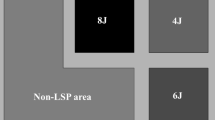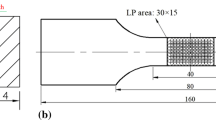Abstract
Steel 20KhN2M is used for the production of gears and other components, for whose service enhanced wear resistance is required in retaining resistance to impact loadings. The deformation (warping) and increased brittleness of these components are observed after their bulk hardening. The deformation of the components cannot be completely eliminated, even on hardening with the use of superhigh frequency, radiation. Local laser heating lowers deformation to a significant degree. In this connection. it was interesting to study the effect of laser radiation on the mechanical properties of the indicated components.
Similar content being viewed by others
References
V. S. Kraposhin, “Dependence of depth of hardening of steels and cast irons on conditions of laser radiation,” Fiz. Khim. Obrab. Met., No. 6, 88–96 (1988).
V. S. Kraposhin “Heat treatment of steels and alloys using a laser beam and other progressive types of heating,” in: Results of Sciences and Engineering. Metal Science and Heat Treatment [in Russian], Vol. 21, Vsesoyuznyi Institut Nauchnoi i Tekhnichesoi Informatsii, Moscow (1987), pp. 144–208.
Yu. F. Babikova, S. V. Kayukov, A. N. Pavlov, et al., “Redistribution of carbon and alloying elements under R18 laser treatment,” Fiz. Khim. Obrab. Met., No. 6, 12–127 (1989).
A. Amulevicius, M. Balciuniene, B. Petretis, and D. Juzakenas, “Structural and phase transitions in technically pure iron under influence of laser radiation,” SRIE,1723, 72–76 (1992).
A. A. Uglov, “State of the art of and prospects for laser technology,” Fiz. Khim. Obrab. Met., No. 4, 32–42 (1992).
T. Ekobori, Scientific Bases of the Strength and Failure of Materials [Russian translation], Naukova Dumka, Kiev (1978).
V. S. Litvinov, S. D. Karakishev, and V. V. Ovchinnikov, Nuclear Gamma-Resonance Spectroscopy of Alloys [in Russian], Metallurgiya, Moscow (1982).
A. A. Nikitin, N. T. Travina, I. V. Artamonova, and I. A. Ryzhkov, “Effect of laser alloying on the structure and properties of steel N18K9M5T,” Fiz. Khim. Obrab. Met., No. 6, 128–134 (1989).
S. D. Karakishev, V. A. Korablev, V. A. Ivchenko, et al., “Distribution of chromium and carbon in hardened steel 35Kh5,” Fiz. Met. Metalloved., No. 4, 163–170 (1990).
V. G. Gavrilyuk, V. M. Nadumov, O. P. Oshkaderov, et al., “Low-temperature phase and magnetic transformations in an Fe-Ni-C alloy,” Fiz. Met. Metalloved., No. 7, 128–133 (1990).
S. M. Dubiel and W. Zinn, “Application of the Massbauer effect in the investigation of the substitution induced spin and charge density changes in bcc-iron,” J. Mag. Mag. Mater.,45, 298–304 (1984).
Additional information
Physics Institute, Vilnius, Latvia. Translated from Metallovedenie i Termicheskaya Obrabotka Metallov, No. 1, pp. 22–14, January, 1994
Rights and permissions
About this article
Cite this article
Amulevicius, A., Balciuniene, M., Petretis, B. et al. Mechanical properties of steel 20KhN2M after laser treatment. Met Sci Heat Treat 36, 18–21 (1994). https://doi.org/10.1007/BF01408596
Issue Date:
DOI: https://doi.org/10.1007/BF01408596




